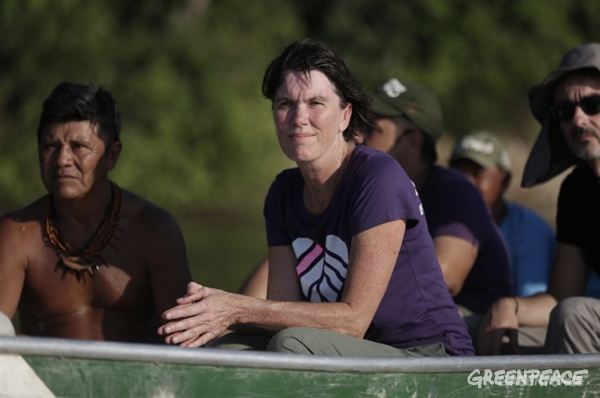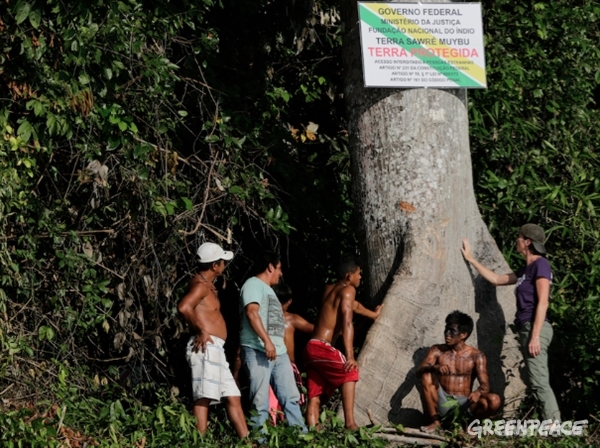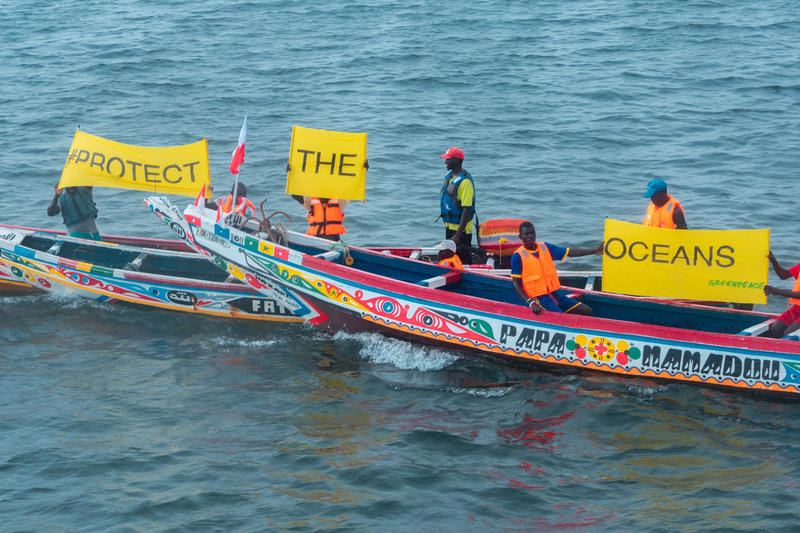The global campaign for the protection of the Tapajos River and Munduruku people has received the support of one million people coinciding with the visit of Greenpeace International Executive Director, Bunny Mcdiarmid.
Bunny McDiarmid is in the heart of the Amazon working side by side with the Munduruku people against the construction of the hydroelectric plant in the Tapajós River in São Luiz. The arrival of the International Executive Director in the indigenous community coincided with the global petition reaching over one million signatures asking that the Rio Tapajós River be kept alive.

Bunny McDiarmid, International xecutive Director of Greenpeace , navigate the Rio Tapajós with Munduruku leaders (Lunae brill/Greenpeace)
The hydroelectric plant, if built, will create a reservoir that’s almost the size of New York City (729 square kilometers) which will destroy the lives of Munduruku Indians in the Amazon Forest.
“There are no better guardians for the Tapajós River than the Munduruku people, who have lived here in harmony with this part of the Amazon for centuries. The power plant in São Luiz is a threat to the Mundurukú people, the Tapajós River as well as the largest rainforest in the world, the Amazon” said McDiarmid. “Just a few months ago, few people in the world knew the struggle of the Munduruku people. Today, over a million people are standing against this project with them. This shows the enormous global support that the Mundurukú people have in their struggle against hydroelectric and forest protection.”
The International Director met with one of the first native chief of the Munduruku people. For Maria Nicaea Akay Mundurukú, the river is the blood of his people. “The dam threatens all, not just the Indians. Animals – birds, fish, turtles – are also affected. They do not know what’s coming to kill them. The dam will kill everything, rivers, fish and forest. That’s why the Mundurukú people are against this project.”

McDiarmid also joined other chieftains for an overflight over the jungle in order to closely witness the destruction caused by dams already built in the area. Then she joined a group of natives to help with the self-demarcation of its sacred territory called Sawré Muybu.
The self-demarcation of their land is a collaboration between the Munduruku people and Greenpeace. Workshops are held to teach the community how to use a lamp and an oven from solar energy. The installation of solar panels was also held in community centers in two villages to demonstrate how renewable energy can be the solution for the country.
The important part of the resistance against the hydroelectric plant in São Luiz also has to do with multinational companies that provide the technology to build it. Companies like Siemens, involved in the destructive Tapajós hydroelectric plant, need to recognize the social and environmental impacts already made by the Belo Monte hydropower plant and leave the partnership. To do this, Greenpeace created an online platform in 13 languages where people can send their messages to these companies.
Next week, McDiarmid will go to Brasilia for a meeting with the Minister of the Environment, Sarney Filho, who is also against the construction of the hydroelectric plant in the Tapajós River.
In Africa, the struggle is the same, in Cameroon and in the DRC, dams are built without a proper Environmental and Social Impact Survey to mitigate negative impacts of the projects on the local communities and the forests. Communities are not consulted for their prior and informed consent while these projects are impacting life which is linked to the forest.
Another threat is the illegal deforestation of the Congo Basin. The Congo Basin is the second largest forest after the Amazon. More recently, the UK authorities sanctioned 14 UK importers sourcing timber from Cameroon linked to illegal logging. Also, just yesterday, we revealed how the DRC government violated its own 2002 moratorium on new logging titles by granting illegal titles to 3 enterprises in 2015. Stand with us, sign this petition and let’s protect the Congo Basin!


